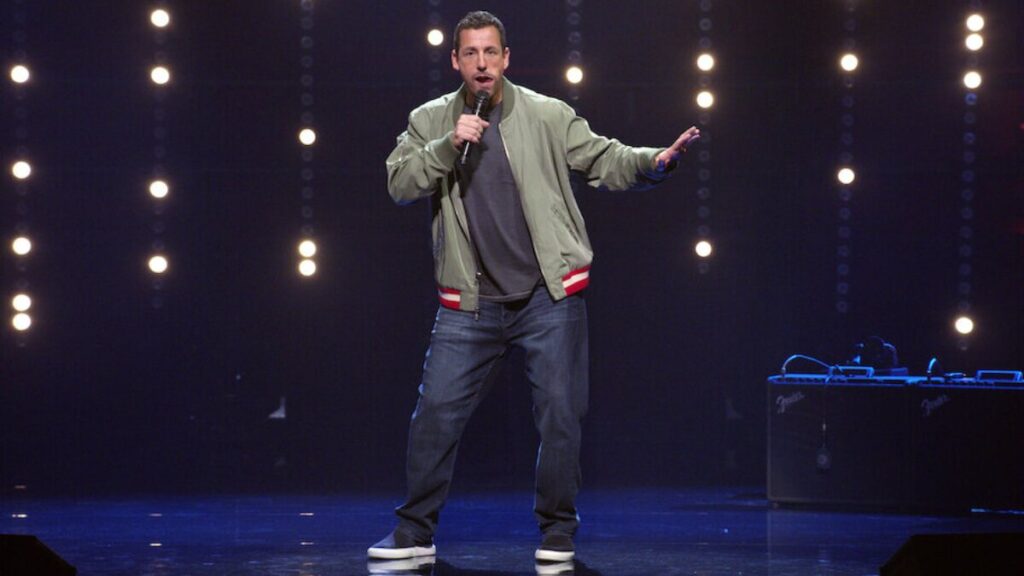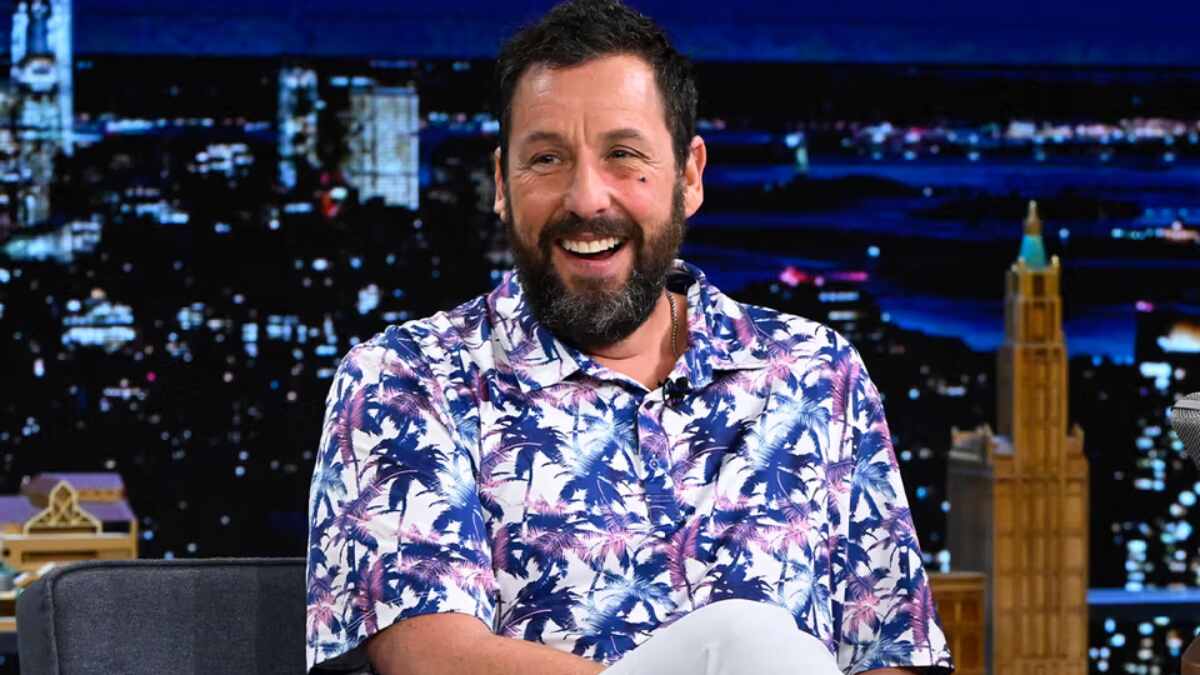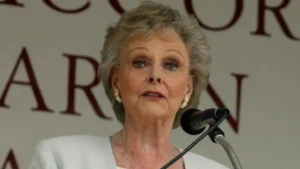“I just wanted to make my friends laugh,” Adam Sandler once said. “That’s all I’ve ever really cared about.”
It sounds simple. Modest, even — a shrug of a mission statement from a man who built an empire in baggy shorts and dad jokes. But the numbers tell a different story.
In the summer of 2020, while critics were still roasting Hubie Halloween and Twitter debated whether Sandler was a genius or a hack, Netflix quietly renewed his deal. Another nine-figure contract. Another stretch of streaming dominance. Off-screen, Sandler was courtside at Knicks games, laughing with Chris Rock, wearing a hoodie three sizes too big and sneakers no stylist would touch. No entourage. No fuss. Just a guy who looked like he wandered into Hollywood by accident — and somehow left with $440 million.
That’s the contradiction. Sandler doesn’t sell glitz; he sells comfort, familiarity, and the long game. While the industry chased prestige, he quietly built one of the most profitable comedy machines in entertainment history. And in 2025, that machine is still running — faster, smarter, and richer than ever.
This isn’t just the story of an actor’s net worth. It’s the story of how being underestimated became Adam Sandler’s greatest asset — and how a guy who never cared about the critics ended up beating the system.
From Brooklyn to Billion-Dollar Laughs: Sandler’s Rise to Hollywood Royalty
A Brooklyn Kid with a Joke Book
Adam Sandler didn’t grow up with dreams of stardom — he grew up with a knack for cracking up his family at the dinner table. In the Sandler household, laughter wasn’t a performance; it was part of the rhythm of life. His mother, a nursery school teacher, and his father, an electrical engineer, were the kind of parents who’d laugh hard but call it out if the joke flopped. That balance — love and critique — became a foundation.
Brooklyn in the late ’60s and early ’70s wasn’t polished. It was loud, diverse, and full of characters — the perfect training ground for a young mind absorbing accents, cadences, and quirks. Sandler didn’t journal or write plays; he absorbed voices, exaggerated them, and played them back for laughs. By the time he hit adolescence, he had already developed the comic’s instinct: not just knowing what’s funny, but knowing when to say it.
Saturday Night Live – The Launchpad of a Lifetime
When Adam Sandler joined Saturday Night Live in 1990, he wasn’t a polished sketch actor — he was chaos wrapped in charm. At a time when SNL was heavy on political satire and ensemble-driven scenes, Sandler brought something different: absurdist characters, goofy songs, and a raw, unapologetic weirdness that split the audience in two. You either got it, or you didn’t — and millions did.
From his childlike Opera Man to the unforgettable “Lunch Lady Land,” Sandler’s sketches didn’t just make people laugh — they became cultural imprints. His characters were awkward, sweet, sometimes idiotic, but never mean-spirited. That was his superpower: he made you laugh with the joke, never at someone else.
More than a career break, SNL was where Sandler tested — and proved — that his brand of humor had legs. It was the first real glimpse of a voice that didn’t care about critics, only connection.
Counting the Cash: What Is Adam Sandler’s Net Worth in 2025?
As of 2025, Adam Sandler’s estimated net worth sits at a staggering $440 million, according to Parade. But unlike many stars whose fortunes are tied to fleeting box office success or splashy endorsements, Sandler’s wealth is the product of consistency, creative control, and a business model most of Hollywood underestimated.
It starts with longevity. For over three decades, Sandler has been a reliable draw — whether in theaters, on DVDs, or now, through streaming giants like Netflix. But beyond acting fees, the real money comes from ownership. Through his production company, Happy Madison, Sandler doesn’t just star in movies — he produces them, hires the team, and takes a share of the backend profits. Every project is a closed-loop ecosystem that feeds his empire.
Then there’s the historic Netflix deal, which began in 2014 and has since been renewed multiple times, reportedly earning him well over $250 million to date. While critics debated the quality, the numbers didn’t lie — his films consistently ranked among Netflix’s most-watched.
In an industry chasing awards and headlines, Sandler played a different game. He built a comedy cash machine — one streaming view, one joke, one hoodie-wearing appearance at a time.
The Netflix Effect: How Sandler Reinvented His Brand for the Streaming Era
A $250 Million Gamble That Paid Off
When Adam Sandler signed his first four-film deal with Netflix in 2014 — reportedly worth up to $250 million — the reaction from critics was swift and smug: Why would a streaming service bet big on a guy whose movies were bombing with reviewers?
But that skepticism didn’t last long.
Within days of release, The Ridiculous 6 became the most-watched title on Netflix in multiple regions. No theatrical rollout. No press tour. Just Sandler’s familiar face, a click away on living room screens — and it worked. Viewers didn’t care about Rotten Tomatoes scores. They wanted comfort, chaos, and a cast of regulars they knew by name.
The strategy was simple but powerful: make movies fast, make them cheap (by Hollywood standards), and make them re-watchable. Netflix got sticky engagement. Sandler got creative control, backend rewards, and the rarest thing in show business — security.
In hindsight, the gamble wasn’t Sandler’s. It was Hollywood’s forever betting against him. And by 2025, that deal had grown into a multi-renewal partnership that helped redefine how comedy survives — and thrives — in the streaming age.
From ‘Ridiculous 6’ to ‘Murder Mystery 2’: Box Office vs. Stream Count
In the traditional box office era, Adam Sandler’s films were often commercial hits in spite of critical disdain. Movies like Grown Ups and Just Go with It made hundreds of millions globally, even as reviewers rolled their eyes. But when Sandler transitioned to Netflix, something shifted — not in the content, but in how success was measured.
On streaming, Sandler wasn’t just profitable — he became a viewership juggernaut. The Ridiculous 6 broke internal records. Murder Mystery clocked over 30 million views in its first weekend, making it one of Netflix’s most-watched originals at the time. By the time Murder Mystery 2 dropped in 2023, Sandler was no longer a “surprise hit” — he was part of the algorithm.
Theater box office depended on opening weekends. Netflix depends on replays, retention, and global reach. And Sandler’s brand — silly, safe, low-stakes fun — plays perfectly across cultures and age brackets. He doesn’t need to dominate headlines. He just needs to be the easy choice on a Friday night.
In the streaming age, Sandler didn’t just adapt. He became the template.
The Powerhouse Behind the Scenes: Happy Madison Productions
Producing Hits for Friends and Family
To outsiders, it might look like nepotism. To Adam Sandler, it’s just loyalty.
Since the early days of Happy Madison Productions, Sandler has filled his films with a familiar cast of friends — Rob Schneider, Kevin James, David Spade, and Steve Buscemi, among others. It’s not just tradition; it’s a deliberate ecosystem. These aren’t cameos. They’re cornerstones in a creative model built on trust, chemistry, and speed.
The formula is simple: surround yourself with people who get your timing, know your instincts, and can shoot a scene without a dozen takes. That synergy saves time and budget — but more importantly, it builds consistency. Whether the critics groan or cheer, Sandler’s films feel familiar. And that familiarity is profitable.
There’s something undeniably warm about watching Grown Ups or The Do-Over and realizing you’re essentially crashing a private joke between lifelong friends. Sandler’s movies might be about goofballs — but behind the scenes, it’s one of the most tightly run, loyal operations in Hollywood.
Leveraging Creative Freedom into Financial Leverage
Adam Sandler doesn’t just star in his films — he owns the scoreboard.
Through Happy Madison Productions, Sandler controls the full pipeline: casting, script development, budgets, marketing tone, and even shooting locations. That creative control isn’t just about freedom — it’s about leverage. When you own the production, you don’t just get paid to act. You get a slice of everything: streaming rights, international licensing, residuals, and sometimes even merchandise.
This ownership model means Sandler’s income scales beyond a flat actor’s fee. A mid-budget comedy that underperforms in theaters? Still profitable when you’re the producer, distributor, and star. A silly streaming release that critics dismiss? Gold when it racks up 100 million views and renews your Netflix deal.
By calling his shots, Sandler has turned creative instinct into a financial engine. He doesn’t need to chase tentpole franchises — he built one, starring his friends, shot on his schedule, and owned in full.
A Celebrity Portfolio: Real Estate, Investments, and Beyond the Screen
Multi-Million Dollar Homes from Malibu to New Hampshire
Adam Sandler could live anywhere — and he does, kind of. But not in the way you’d expect from a man worth over $400 million.
His real estate portfolio includes a sprawling mansion in Pacific Palisades, a Malibu beach house, and properties in New Hampshire, Long Island, and Florida. These aren’t just luxury pads — they’re footprints of a life that’s deliberately low-key. No paparazzi playgrounds, no over-the-top architectural statements. His Malibu home is comfortable, not flashy. His East Coast properties keep him close to family and friends, not parties.
Sandler’s homes are less about opulence and more about orbit. He moves between coasts like someone who never quite bought into Hollywood’s center of gravity. In many ways, his real estate mirrors his public persona: warm, unpretentious, rooted in familiarity. It’s not about being seen — it’s about feeling at home, wherever the next film or family moment takes him.
Side Ventures: Basketball Courts, Endorsements, and Unexpected Assets
Adam Sandler’s business moves don’t always look like business moves — and that’s exactly the point.
He’s been spotted courtside at countless NBA games, not as a publicity stunt but as a genuine fan who plays pickup almost daily. That love for basketball has quietly crept into his brand: Hustle (2022) earned him serious respect from sports fans and players alike, and he’s cultivated real relationships with NBA stars that have translated into cultural cachet — and streaming clicks.
Then there are the Sandler-isms that sneak into the mainstream: his love for oversized Champion shorts, vintage tees, and worn sneakers has sparked viral fashion discourse and even inspired unofficial merch drops. He’s not pushing products — he is the product.
Sandler rarely endorses brands in the traditional sense, but his cultural value shows up in resale spikes, surprise partnerships, and indie cameos. His side ventures aren’t flashy. They’re accidental gold — powered by authenticity and accidental cool.

How Does Adam Sandler’s Net Worth Compare to His Comedy Peers?
Sandler vs. Seinfeld, Rock, and Ferrell: Who’s on Top in 2025?
In the money game of modern comedy, Adam Sandler isn’t just playing — he’s winning.
As of 2025, Sandler’s estimated $440 million net worth puts him in rare air. Jerry Seinfeld still leads the pack with a reported $900 million, thanks largely to Seinfeld’s syndication windfall and savvy Netflix licensing. But beyond Jerry’s sitcom-fueled fortune, the race gets interesting.
Chris Rock, boosted by stand-up tours and selective acting roles, sits around $60–70 million, while Will Ferrell, despite blockbuster hits and producing success, hovers near $160 million.
So what sets Sandler apart? Ownership and volume. Through Happy Madison, he produces multiple projects a year. Add in long-term Netflix partnerships, backend deals, and self-funded hits, and his earnings compound.
While others chase peak prestige or viral hits, Sandler built a scalable, evergreen comedy empire. He might not have Seinfeld’s syndication monster, but in terms of annual momentum and cultural relevance? Sandler’s laughing all the way to the bank — and back again.
Defining Success Beyond the Dollar Sign
It’s easy to crown a winner based on dollar signs — but money isn’t the only metric that matters in comedy. Jerry Seinfeld may have the biggest bank account, but Adam Sandler arguably has something rarer: generational staying power.
His films, whether critically beloved or brutally panned, have become rites of passage — quoted by teens, rewatched by adults, and discovered by new audiences on streaming. He’s created a comedic language all his own: part slapstick, part sincerity, entirely recognizable.
Sandler didn’t just build wealth; he built affection. And that brand of emotional currency — the kind that can’t be counted but constantly recirculates — might be the most valuable asset of all. Because long after the contracts fade, people won’t remember the net worth. They’ll remember how his movies made them laugh exactly when they needed to.
More Than Money: Philanthropy, Personal Life, and Staying Grounded
Generosity Behind the Goofball Persona
Adam Sandler doesn’t put his philanthropy on stage — he slips it in quietly, much like his punchlines. While he’s made sizable donations to causes like children’s hospitals, disaster relief, and education programs, it’s the smaller, off-the-radar gestures that reveal his character.
He’s been known to quietly pay for college scholarships in his hometown of Manchester, NH. After wrapping Uncut Gems, he gifted bonuses to crew members out of pocket — not for publicity, but out of gratitude. And he routinely donates to the families of late comedians, including supporting the loved ones of longtime collaborators.
Sandler’s style of giving isn’t performative. It’s personal. He gives the way he works — surrounded by the people he cares about, behind the scenes, with a generous heart and zero need for credit.
Family First — A Lifestyle That Defies Hollywood Stereotypes
While some celebrities orbit red carpets and tabloid drama, Adam Sandler has built his world around something far quieter: family.
He’s been married to actress Jackie Sandler since 2003, often casting her — and their two daughters — in small roles in his films. But beyond the screen, Sandler is almost defiantly domestic. He skips Hollywood parties for school drop-offs. He brings his kids to sets. His vacations aren’t splashed across gossip sites because they’re not meant for cameras.
This low-profile home life isn’t a rebrand — it’s always been the brand. That steadiness, that refusal to perform offscreen, is part of what keeps him grounded — and what’s quietly fueled a career built more on trust than spectacle.
What I Learned from Watching Adam Sandler’s Career
I used to think Adam Sandler was just the guy who made people laugh with funny voices and fart jokes. I grew up on Billy Madison and Happy Gilmore, quoting them with my friends like scripture — not because they were critically acclaimed, but because they were ours. They made us laugh when nothing else did. And for a long time, that’s all I saw.
But somewhere along the way — maybe during Punch-Drunk Love, or more recently with Hustle — I started noticing something deeper. Sandler wasn’t chasing reinvention; he was evolving without the spotlight needing to notice. He didn’t ask for critical approval. He just kept making what he loved, lifting his friends with him, and staying grounded in a world built to pull people apart.
There’s a lesson in that — for creatives, for entrepreneurs, for anyone trying to do meaningful work in a noisy world. You don’t have to play the loudest game to win. You just have to know what matters to you — and build around it.
Sandler did. And in doing so, he built not just a fortune, but a career that never asked for validation — and ended up earning something more valuable: loyalty.
What Adam Sandler’s Fortune Tells Us About Laughing All the Way to the Bank
Adam Sandler didn’t follow Hollywood’s rulebook — he scribbled his own playbook in the margins, passed it to his friends, and somehow turned it into a $440 million empire. His career isn’t just a testament to staying power; it’s a blueprint for what happens when creative instinct meets business savvy and loyalty becomes a competitive advantage.
He never chased Oscars, trended on red carpets, or tailored his brand to what critics demanded. Instead, he doubled down on what he knew: how to make people laugh, how to build something sustainable, and how to keep the people he trusts close. In an industry obsessed with reinvention, Sandler proved that consistency — when rooted in authenticity — can be just as powerful.
His story isn’t about a fluke or a single breakout role. It’s about endurance. About doing the work, ignoring the noise, and turning every joke, every goofy walk, every low-stakes comedy into another brick in a quietly brilliant financial legacy.
And maybe that’s the real punchline: that the guy who never looked like a mogul became one — by simply knowing who he was and never letting go of it.
Nishant Wagh is the founder of The Graval and a seasoned SEO and content strategist with over 15 years of experience. He writes with a focus on digital influence, authority, and long-term search visibility.





5 thoughts on “Inside Adam Sandler’s $440 Million Comedy Empire: How Loyalty, Laughter, and Netflix Built a Hollywood Icon”